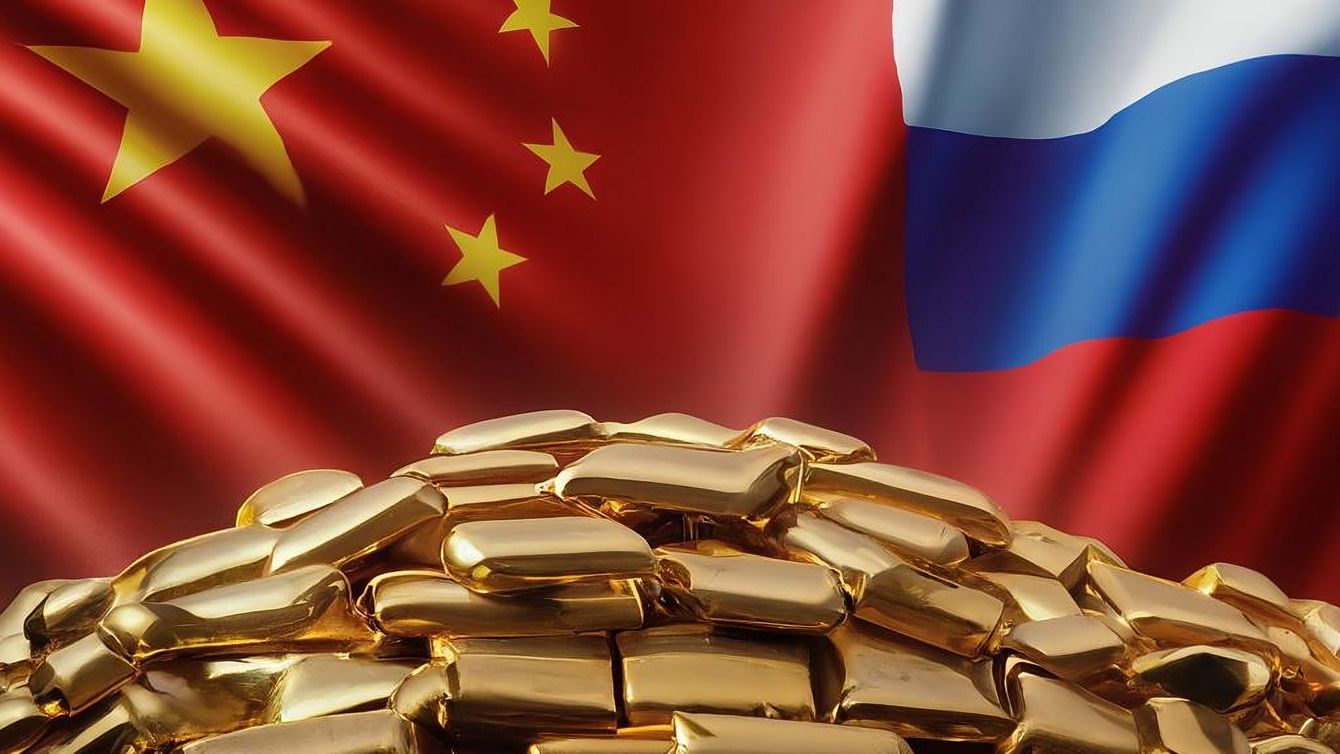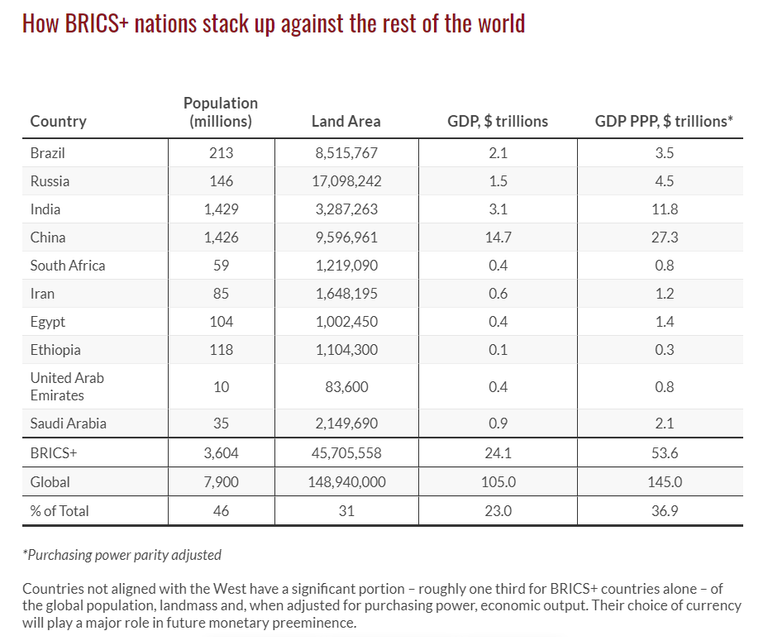SPOT MARKET IS OPEN (WILL CLOSE IN 6 HRS. 9 MINS. )
Live Spot Gold
Bid/Ask
2,363.302,364.30
Low/High
2,357.102,400.60
Change
-33.00-1.38%
30daychg
+37.40+1.61%
1yearchg
+395.70+20.11%
Silver Price & PGMs

In an analysis for intelligence consultancy GIS published Wednesday, Roth noted that gold’s surge to a new all-time high of $2,480 per ounce on July 17 underscores strategic moves by central banks in BRICS+ and other countries against a backdrop of geopolitical and economic uncertainty.
“This is a significant jump from its previous record of $2,075, set in August 2020, amid the pandemic-induced uncertainty and consequent safe-haven demand,” he wrote.
Roth said the runup in price is not surprising given the ongoing geopolitical turbulence. “There are two active wars – in Ukraine and the Middle East – and either (or both) could escalate at any moment into a wider international conflict,” he said. “Meanwhile, immensely influential elections are taking place this year: in India, the United Kingdom and the European Union incumbents lost clout, Mexico has a new leader with the same leftist program, and the unpredictable November presidential election in the United States is drawing closer.”
“Sociopolitical tensions, deep ideological divisions and dangerous polarization are becoming the norm worldwide.”
Roth said that while inflation is moderating, “easy monetary policy” remains a long way off. “While price pressures have retreated from the near-double-digit highs we witnessed in several advanced economies over the last couple of years, there is still considerable pressure on countless households and businesses,” he wrote. “It will likely again rear its ugly head as governments consider raising taxes to pretend to address gaping fiscal deficits.”
He said that the yellow metal is performing exactly as expected under the circumstances. “When doubt and uncertainty reign supreme, investors flock to the safest of safe havens – in dark and unsettling times, that’s when gold reliably and predictably shines its brightest,” he wrote.
“There is, however, a plot twist,” he said. “Since the beginning of the year, even as prices were climbing from one record high to the next, numerous gold dealers in Europe were simultaneously reporting that retail investors’ purchases were becoming few and far between, yet selling activity was actually picking up. Sure enough, official data confirmed the anecdotal reports: Retail demand was indeed decisively falling, while the gold price kept rising.
Roth said that the demand fueling these new record highs was coming from somewhere other than consumers and investors. “Central bank purchases have been a key driver of gold’s price surge, which is interesting in and of itself, given the general disdain that so many central bank officials and policymakers have historically shown towards the metal,” he said. “However, there is something even more interesting and much more widely and deeply consequential at play here if one takes a more detailed look at the specific central banks behind this buying spree.”
He cited the latest World Gold Council data which shows that the most active sovereign purchasers in Q1 2024 were “the People’s Bank of China, which added 27 tons to its gold reserves; the Central Bank of Turkey, which increased its holdings by over 30 tons; the Reserve Bank of India, which bought 19 tons; and the National Bank of Kazakhstan, which added 16 tons.”

“Of course, neither the timing of these purchases nor their scale is a coincidence,” Roth said. “This voracious buying didn’t just come out of nowhere. China has been expanding its reserves with fresh purchases every single month since October 2022, pausing only this spring, and it is expected to resume as soon as price levels pull back.”
He noted that Russia also aggressively increasing its gold reserves, with the yellow metal now representing over 29% of the country’s total reserves, a massive increase from 11.8% just six years ago. “Other nations within the Sino-Russian sphere of influence, and even some that are generally perceived as neutral, also began their gold stockpiling efforts around the same time,” he said.
Roth believes gold’s rise is primarily a reaction to the weaponization of the U.S. dollar. “The world reserve currency, the anchor, the stabilizer and the trusted medium of exchange that countless countries rely upon, can and will be used as an offensive weapon in geopolitical conflicts,” he wrote. “That same weapon that has been wielded against Russia could be deployed against any other adversary.”
The rise and expansion of BRICS+ has also played a role, Roth noted.
“The grouping has been advocating for a more multipolar world order, and its founding members have aired the idea of launching a gold-backed currency,” he said. “No matter how one assesses the realistic prospects of such a currency and its potential real-world impact, and despite the fact that BRICS+ is a rather loose alliance (compared to the European Union, for instance), the fact remains that the group encompasses about 3.5 billion people or 45 percent of the global population, controls 30 percent of the world’s land surface, and its members’ economies account for over 37 percent of global GDP.”
Roth shared three de-dollarization scenarios and their potential impact on gold.
In the first scenario, non-Western gold purchases will continue. Roth considers this outcome “Very likely.”
“What seems entirely likely is that gold demand from BRICS+ members and non-U.S. aligned nations will continue to outstrip Western purchases,” he wrote. “An outcome of this will be drift in the center of geopolitical gravity.”
The second scenario, which Roth believes is possible in the long term, is that gold-backed economies dethrone the U.S. dollar.
“As more nations accumulate more gold and slowly reduce their dependency on the U.S. dollar, the West’s geopolitical influence will inevitably grow weaker,” he wrote. “As a result, the U.S. and its allies will have fewer levers at their disposal to enforce their global agenda. Eventually, they will be less and less able to protect their interests.”
The third and least likely possibility in Roth’s estimation is the complete de-dollarization of the Global South.
“A scenario of complete dedollarization could lead to a tectonic shift in the global geopolitical order,” he said. “In the extreme situation of the U.S. dollar being rendered effectively irrelevant, superpowers-in-waiting – Russia and China – could pose an existential threat to the current U.S.-dominated power structure. However, this appears unrealistic in the foreseeable future.”
Roth points out that the USD has no viable rivals among other fiat currencies. “The euro, though it did manage to emerge as the second most widely held reserve currency (representing about 20 percent of international foreign currency reserves), still fails to pose a credible threat to the greenback’s global dominance,” he wrote. “The Japanese yen or the British pound were never serious contenders, and the Chinese renminbi presents even less of a challenge: Its share of global foreign currency reserves dropped to 2.3 percent last year from its peak of 2.8 percent in 2022.”
“Gold is the only workable and viable alternative to the American currency,” he concluded. “A widely accepted and reliable gold-backed currency, like the one that China and Russia have advocated for, certainly seems like an unlikely scenario – though it is not inconceivable. Highly improbable as it may be, should it come to pass, it would irrefutably mark the beginning of the end of the era of fiat currencies.”
Posted by:
Jack Dempsey, President
401 Gold Consultants LLC
jdemp2003@gmail.com

